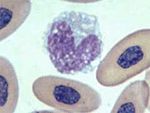|
|
| (32 intermediate revisions by 4 users not shown) |
| Line 1: |
Line 1: |
| − | [[Image:LH Monocyte Histology.jpg|right|thumb|150px|<p>'''Monocyte'''</p><sup>©RVC 2008</sup>]] | + | [[Image:Monocyte.jpg|150px|thumb|right|'''Monocyte''' (Copyright © RVC. All rights reserved)]] |
| − | ==Introduction==
| |
| − | Monocytes are the largest [[Leukocytes|leukocytes]]. They have a large indented nucleus, few granules and constitute about 5% of circulating leukocytes. Monocytes are precursors to a number of cells that make up the [[Lymphoreticular System - Anatomy & Physiology|mononuclear phagocytic system]]. Developing in the [[Bone Marrow - Anatomy & Physiology|bone marrow]], monocytes migrate into the circulation where, after approximately three days, they migrate into tissues and differentiate.
| |
| | | | |
| − | ==Development==
| + | Monocytes are generally the largest [[Leucocytes|leucocyte]] and have a nucleus that is ovoid and indented (often bean shaped). The cytoplasm usually stain blue-gray and often is vacuolated. The monocytes range is generally between 0 and 10% of the differential and may increase in chronic infections. |
| − | <p>Monocytes develop from the bi-potential [[Haematopoiesis - Overview#Colony Forming Units|CFU-GM]] stem cell during [[Leukopoiesis|leukopoiesis]].</p>
| |
| − | <p>When monocytes leave the blood stream they then differentiate into a number of cells (all are classified as [[Macrophages|macrophages]]):
| |
| − | * Connective tissue histiocyte
| |
| − | * [[Respiratory System General Introduction - Pathology#Alveolar macrophages|Alveolar macrophage]]
| |
| − | * Peritoneal macrophage
| |
| − | * Liver Kupffer cell
| |
| − | * Melanophage of skin
| |
| − | * Lipophage
| |
| − | * [[Bones - Anatomy & Physiology#Osteoclasts|Osteoclasts]] in bone
| |
| − | * [[Neurons_- Anatomy & Physiology#Microglial_Cells|Microglial cell]] in bone & brain
| |
| − | * Specialised histiocytes
| |
| − | ** Epithelioid cell
| |
| − | * Histiocytic giant cell
| |
| − | ** Langerhans cell
| |
| − | ** Touton giant cell</p>
| |
| − | [[Image:Monocyte Picture.jpg|thumb|right|150px|Monocyte Picture - Copyright Prof Dirk Werling DrMedVet PhD MRCVS]]
| |
| | | | |
| − | ==Action==
| + | [[Category:Lizard_and_Snake_Glossary]] |
| − | <p>During inflammation chemokines attract monocytes which migrate out of blood vessels into the damaged tissue, where they differentiate into cells of the [[Lymphoreticular System - Anatomy & Physiology|mononuclear phagocytic system]].</p>
| |
| − | <p>Monocytes can live for months to years in the circulation.</p>
| |
| − | <p>Monocytes are referred to as macrophages once they enter a tissue by '''diapedesis'''.</p>
| |
| − | <p>Monocytes/macrophages act as phagocytes, removing particular antigens. They also act as antigen presenting cells to take up, process and present antigen to [[T cells]].</p>
| |
| − | ==Monocytosis==
| |
| − | An increase in the number of monocytes (haematogenous macrophages) in the blood is known as a [[Monocytosis|monocytosis]]. It occurs in conjunction with other changes inidicative of a [[Stress Leucogram|stress leucogram]] or it may occur independently. Monocytes in the blood represent a brief transitional stage as they quickly move into tissues and differentiate further to tissue macrophages; they rarely perform any notable functions whilst in the bloodstream but they have been found to phagocytose red blood cells in cases of immune-mediated haemolytic anaemia. The major causes of monocytosis are:
| |
| − | *Stress leucogram mediated by the production or administration of glucocorticoids (plus a neutrophilia, eosinopenia and lymphopenia).
| |
| − | *Chronic inflammatory processes, including chronic bacterial infections and chronic inflammatory diseases of the liver (chronic hepatitis and cholangitis) and pancreas (chronic pancreatitis).
| |
| − | *Granulomatous disease results in monocytosis as monocytes are recruited to contain certain types of bacteria (namely Mycobacteria spp., Nocardia spp., Actinomyces and Rhodococcus equi) or foreign bodies.
| |
| − | *Certain types of monocytic or myelomonocytic chronic myeloid leukaemia may result in the presence of large numbers of monocytes in the blood.
| |
| − | | |
| − | [[Category:Blood_Cells]] [[Category:Kate English reviewing]]
| |
